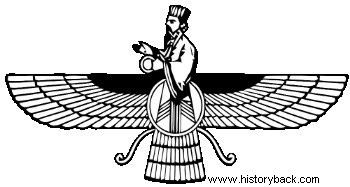Zoroastrianism, or Masdeism, became the religion from state Persian on century VI a.C . This belief was replaced by Islam only around the 7th century AD. after the fall of the Sasanian Empire.
In Iran (ancient Persia), a small part of the population still practices Zoroastrianism, whose largest number of adherents are Indians.
In short, this ancient religion has as its principle the concrete existence of good and evil, that is, that is why it is a dualistic religion.
Principles of Zoroastrianism
The supreme principles of good and evil are represented by the twin brothers Ahura Mazda , who is the god of good, and Aritman , who is the god of evil.
As it would have been revealed to Zoroaster, these two gods lived in fight. The end of time would be marked by Mazda's victory over Arithman. Therefore, people should choose the path they wanted to follow, knowing that through their actions they could go to hell after their death.
Followers of Zoroastrianism believe in the resurrection of the dead, as well as in paradise, purgatory and hell, as preached in Roman Catholicism. Likewise, this religion believes in the prophecy of the end times.
The emperors were the representatives of the god Mazda on Earth, so it was possible to guarantee the subjugation of the people to the ruler of the empire.
Discover other aspects of the important civilization of the Persians.
Zoroaster - The Prophet
The name of the religion comes from its founder, the prophet Zoroaster (628 BC and 551 BC), also known as Zarathustra, who, fusing popular beliefs with his teachings, gave rise to Zoroastrianism.
Not much information is known about Zoroaster's life and some studies say that it was a title of priests or sages, and not a proper name.
Anyway, Zoroaster was a priest, to whom divine revelations were made when he was 30 years old. Receiving these revelations, he began to preach them and soon gained enemies such as the "karpans" who maintained customs that contradicted Zoroaster's teachings and the "kawis" who also opposed him. As a result, he was persecuted and had to flee his homeland.
Thus, a legend arises that says that Zoroaster cured a ruler's horse, which would have allowed the prophet to preach freely in the place where he ruled, northeast Persia. In this way, Zoroaster won thousands of followers and spread his belief.
Zoroastrian priests were called magi, a word that comes from the Greek magikos . The religion, however, is not based on magical traditions.
Symbols and Holy Books

The main symbol of Zoroastrianism is the Faravahar or Ferohar which represents the soul before birth and after death.
The fire it is another important element, for the god of good is worshiped through the sacred fire that is kept lit by the priests in Zoroastrian temples. In order to protect themselves from inhaling the gases produced, followers of Zoroastrianism wear white masks.
Cremation was not allowed for Zoroastrian believers, as fire was considered sacred. They believed that the corpse-burning technique could contaminate it.
The holy book of Zoroastrianism is called the Avesta . Like the Bible for Christians, it contains prayers, hymns and teachings. One of its most important parts is the book from Gathas , where the 17 songs composed by Zoroaster are written.
Meet others religions:
- Taoism
- Buddhism
- Shinto
- Hinduism
- Religious Intolerance
